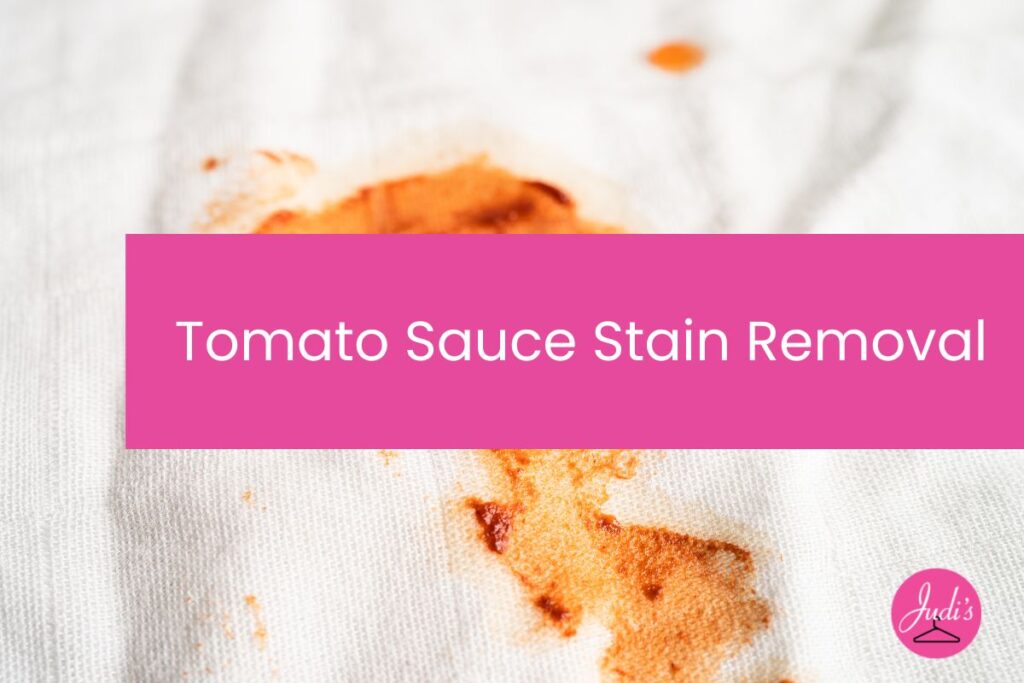Tomato sauce stain removal can be important knowledge to have. Whether it’s from a messy dinner or an accidental spill, tomato sauce stains can leave a lasting mark on your favorite shirt. But don’t worry; we’ve got you covered with some tips and tricks for removing those pesky stains.
One of the most important things to keep in mind when dealing with tomato sauce stains is to act quickly. The longer the stain sits, the harder it will be to remove. So, as soon as you notice a stain, try to treat it right away. There are several methods you can use to remove tomato sauce stains, including using household items like salt and baking soda, or using specialized stain removers.
With a little bit of know-how and some elbow grease, you can get rid of tomato sauce stains and have your clothes looking as good as new.
Understanding Tomato Sauce Stains
Tomato sauce stains are one of the most stubborn and challenging stains to remove from clothing, carpets, and upholstery. The acidic nature of tomatoes and the presence of tannins and oils in the sauce can make it difficult to get rid of the stain completely.
When tomato sauce comes into contact with fabric, it can leave behind a bright red or orange stain that can be very noticeable and unsightly. The longer the stain is left untreated, the more difficult it becomes to remove.
To effectively remove tomato sauce stains, it is important to understand the properties of the stain and the fabric it has stained. Different fabrics require different treatments, and using the wrong method can cause irreversible damage to the fabric.
It is essential to act quickly when dealing with tomato sauce stains. The longer the stain is left untreated, the more difficult it becomes to remove. It is recommended to remove the excess sauce as soon as possible using a blunt knife or spoon.
When treating tomato sauce stains, it is important to avoid using hot water or heat as it can set the stain permanently. Instead, use cold water to rinse the stain and blot it with a clean cloth. Avoid rubbing the stain as it can spread the stain and make it worse.
Pre-Treatment Steps
Before attempting to remove tomato sauce stains from clothing, it is important to take the necessary pre-treatment steps. These steps can help to prevent the stain from setting further into the fabric and make it easier to remove.
Blotting the Stain
The first step in pre-treating a tomato sauce stain is to blot the stain with a clean white paper towel, dish towel, or rag. This will help to absorb any remaining liquid or tomato sauce residue on the fabric. Be sure to blot the stain gently to avoid pushing the stain further into the fabric.
Rinsing with Cold Water
After blotting the stain, rinse the affected area with cold water. This will help to remove any remaining tomato sauce residue and prevent the stain from setting further into the fabric. Be sure to use cold water, as hot water can cause the stain to set.
If the stain is particularly stubborn, you may need to soak the garment in cold water for a few hours before attempting to remove the stain. This can help to loosen the stain and make it easier to remove.
Choosing the Right Method of Tomato Sauce Stain Removal
When it comes to removing tomato sauce stains, choosing the right stain remover is crucial. There are many options available, from commercial stain removers to homemade solutions. In this section, we will discuss the pros and cons of each type of stain remover and help you decide which one is right for you.
Commercial Stain Removers
Commercial stain removers are readily available at most stores. They come in different forms, including sprays, powders, and gels. Some are designed specifically for tomato sauce stains, while others claim to work on a wide range of stains.
One advantage of commercial stain removers is that they are usually very effective. They often contain powerful chemicals that can break down even the toughest stains. However, they can also be expensive, and some people may be concerned about the safety of using chemicals on their clothes.
Before using a commercial stain remover, be sure to read the label carefully and follow the instructions. Some products may be too harsh for certain fabrics, and others may require special handling.
Homemade Solutions
If you prefer a more natural approach, there are many homemade solutions that can be effective at removing tomato sauce stains. Some common ingredients include vinegar, baking soda, and lemon juice.
One advantage of homemade solutions is that they are often less expensive than commercial stain removers. They are also generally safe for use on all types of fabrics. However, they may not be as effective as commercial products, and some solutions may require more effort to apply.
When using a homemade solution, be sure to test it on a small, inconspicuous area of the fabric first. This will help you avoid any damage or discoloration. Also, be prepared to apply the solution several times, as it may take some time to fully remove the stain.
Both commercial stain removers and homemade solutions can be effective at removing tomato sauce stains. The choice ultimately depends on your personal preferences and needs. If you want a quick and easy solution, a commercial stain remover may be the best choice. If you prefer a more natural approach, a homemade solution may be the way to go. Whatever you choose, be sure to follow the instructions carefully and take the necessary precautions to protect your clothes.
Stain Removal Process
Removing tomato sauce stains from clothing can be a daunting task, but with the right process, it can be done effectively. Here’s our recommended stain-removal process:
Applying the Stain Remover
First, you need to apply a stain remover to the affected area. There are various stain removers available in the market, but you can also make your own using household items such as dish soap, baking soda, and vinegar.
Here’s how to apply a stain remover:
- Apply a small amount of the stain remover directly to the affected area.
- Gently rub the stain remover into the fabric using your fingers or a soft-bristled brush.
- Let the stain remover sit on the stain for 5-10 minutes.
Rinsing and Repeating
After letting the stain remover sit on the stain, it’s time to rinse it off and repeat the process if necessary.
Here’s how to rinse and repeat:
- Rinse the affected area with cold water to remove the stain remover and tomato sauce residue.
- Check to see if the stain is still visible. If it is, repeat the stain removal process.
- Once the stain has been removed, wash the garment as usual.
It’s important to note that tomato sauce stains can be stubborn, and it may take several attempts to completely remove the stain. Be patient and persistent, and you should be able to get rid of the stain.
In summary, the stain removal process involves applying a stain remover to the affected area, letting it sit for a few minutes, rinsing it off, and repeating the process if necessary. By following these steps, you can effectively remove tomato sauce stains from your clothing.
Post-Treatment Steps
After treating a tomato sauce stain on fabric, there are a few important post-treatment steps to take to ensure the best results. Here are some tips:
Drying the Fabric
Once you have treated the stain, it’s important to let the fabric dry completely before assessing the results. If the stain is still visible after drying, try repeating the treatment process or using a different method.
It’s important to avoid using heat to dry the fabric, as this can set the stain and make it more difficult to remove. Instead, air dry the fabric or use a cool setting on your dryer.
Assessing the Results
After the fabric is completely dry, assess the results of the treatment. If the stain is still visible, try repeating the treatment process or using a different method.
If the stain is no longer visible, wash the fabric as you normally would to remove any remaining treatment residue. Be sure to check the care label on the fabric to determine the appropriate washing instructions.
It’s important to note that some fabrics may require professional cleaning to fully remove tomato sauce stains. If you are unsure about how to treat a particular fabric, consult a professional cleaner for advice.
Overall, with the right treatment and post-treatment steps, tomato sauce stains can be effectively removed from fabric.
Preventing Future Stains
Using Tablecloths
One of the easiest ways to prevent tomato sauce stains from ruining your clothes is to use tablecloths. Tablecloths not only add elegance to your dinner table, but they also protect it from spills and stains. When choosing a tablecloth, it’s important to select one that is made of a durable and stain-resistant material such as polyester or cotton. Avoid using delicate fabrics such as silk or linen, as they are more likely to stain and are harder to clean.
Immediate Action
Another way to prevent tomato sauce stains is to take immediate action when spills occur. The longer you wait to clean up a spill, the harder it will be to remove the stain. If you spill tomato sauce on your clothes, quickly blot the stain with a clean cloth or paper towel to remove as much of the sauce as possible. Avoid rubbing the stain, as this can cause it to spread and become more difficult to remove.
Once you have removed as much of the sauce as possible, rinse the stain with cold water. Avoid using hot water, as this can set the stain and make it even harder to remove. If you are at a restaurant or away from home, ask for a damp cloth or napkin to help clean up the stain.
By using tablecloths and taking immediate action when spills occur, you can prevent tomato sauce stains from ruining your clothes. Remember to always check the care label on your clothes before attempting to remove stains, and when in doubt, you can always consult a professional.
Judi’s Cleaners in Sacramento, CA
If you need professional dry cleaning picked up and delivered throughout the Sacramento area, contact Judi’s Cleaners at (916) 242-0650.

